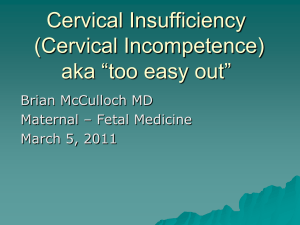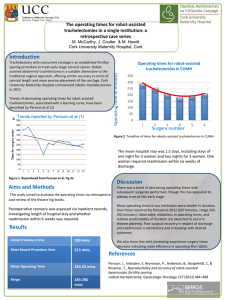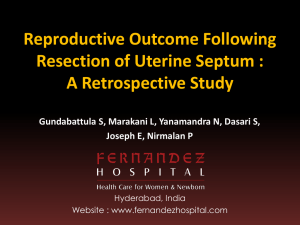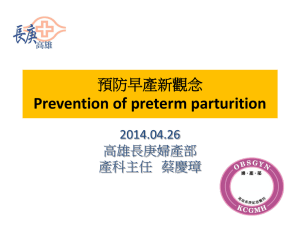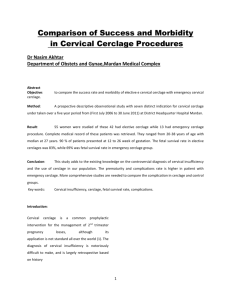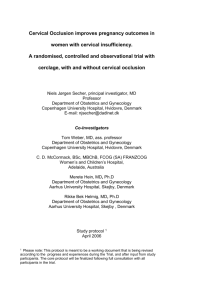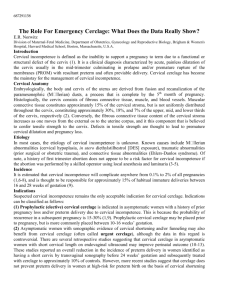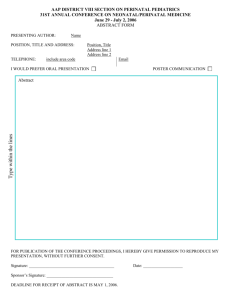THE PERINATAL OUTCOME IN SAUDI WOMEN WITH EMERGENCY
advertisement
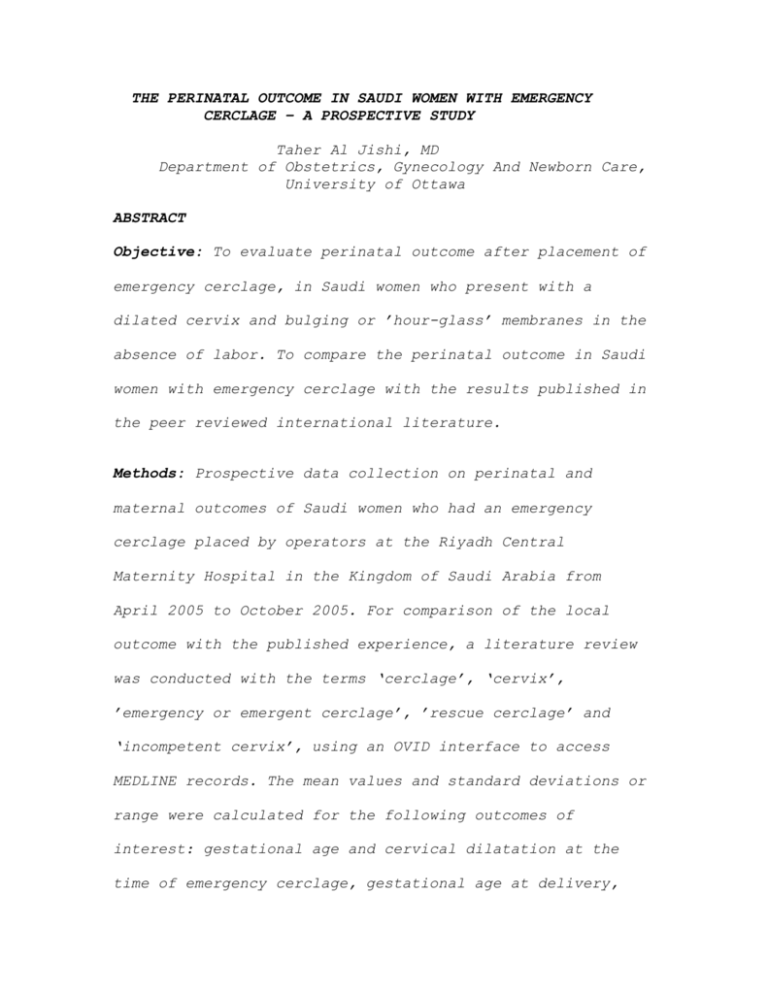
THE PERINATAL OUTCOME IN SAUDI WOMEN WITH EMERGENCY CERCLAGE – A PROSPECTIVE STUDY Taher Al Jishi, MD Department of Obstetrics, Gynecology And Newborn Care, University of Ottawa ABSTRACT Objective: To evaluate perinatal outcome after placement of emergency cerclage, in Saudi women who present with a dilated cervix and bulging or ’hour-glass’ membranes in the absence of labor. To compare the perinatal outcome in Saudi women with emergency cerclage with the results published in the peer reviewed international literature. Methods: Prospective data collection on perinatal and maternal outcomes of Saudi women who had an emergency cerclage placed by operators at the Riyadh Central Maternity Hospital in the Kingdom of Saudi Arabia from April 2005 to October 2005. For comparison of the local outcome with the published experience, a literature review was conducted with the terms ‘cerclage’, ‘cervix’, ’emergency or emergent cerclage’, ’rescue cerclage’ and ‘incompetent cervix’, using an OVID interface to access MEDLINE records. The mean values and standard deviations or range were calculated for the following outcomes of interest: gestational age and cervical dilatation at the time of emergency cerclage, gestational age at delivery, latency of pregnancy from cerclage placement to delivery, birth weight of the infant. Adverse maternal and perinatal outcomes were tabulated. Results: In the specified time frame, 14 women underwent emergency cervical cerclage at the Riyadh Central Maternity Hospital. The average time between cerclage placement and delivery was 7 weeks and 3 days, which allowed for 12 of 14 neonates to be born at 28 weeks or later. 3 neonates had a birth weight under 1000 g. The average neonatal survival was 93%. Histological data are available for 12 placentas. 2 placentas demonstrated a histological diagnosis of chorioamnionitis, although none of the blood cultures from the neonates revealed septicemia. The PPROM rate was 14%. The literature review from 1993 to 2005 identified 24 peerreviewed publications, which described the perinatal outcome of 638 women who underwent emergency cerclage for the same indications as the present cohort study of Saudi women. The average prolongation of the pregnancy was 7 weeks and 1 day. The average neonatal survival exceeded 70% (range 47.2% to 96%) and 60% of the neonates (range 26% to 80%) were born after 28 weeks gestation. Chorioamnionitis was reported in 5% to 80% of pregnancies and preterm premature rupture of the membranes complicated an average of 29% of gestations (range 1% to 58%). Conclusion: The results of this prospective study as well as the data available in the medical literature suggest that emergency cerclage can significantly prolong pregnancy and increase the likelihood of fetal viability. These therapeutic benefits have to be considered in light of the increased risk of chorioamnionitis and associated fetal inflammatory brain insult as well as the risk of extending pregnancy from previability to severe prematurity. INTRODUCTION Prematurity is the single largest factor in neonatal mortality and is responsible for half of all neonatal death (1). Furthermore, preterm birth generates a significant financial burden for the health care system and the society at large, because of the need for intensive neonatal care for several weeks as well as the continuing, often lifelong, support necessary after discharge from hospital. Cervical incompetence represents a component of the heterogenous etiology of prematurity. In current practice, cervical incompetence is associated with a history of passive, painless dilatation of the cervix, which ultimately results in midtrimester pregnancy loss or premature delivery. The etiology of cervical incompetence is unknown in most instances. Traumatic cervical injury, congenital abnormalities, and inadequate collagen or elastin have been suggested as possible causes (2,3). Women with poor pregnancy outcome attributed to cervical incompetence are identified clinically based on the finding of a partly dilated cervix in the absence of labor or by transvaginal sonographic measurement of cervical length. There is controversy whether cervical incompetence is an all-or-none phenomenon. When cervical length, assessed sonographically, is correlated with duration of gestation, cervical competence proves to be a spectrum of performance rather than a dichotomy and the term cervical incompetence becomes a misnomer (4). The placement of a prophylactic cerclage, based on either a history of poor cervical performance in a previous pregnancy or decreased cervical length identified by transvaginal ultrasound, has not been supported by results from randomized trials (1, 5). However if the pregnant woman presents with premature dilatation of the cervix and bulging or ‘hour-glassing’ membranes in the absence of uterine activity, an emergency or rescue cerclage may be indicated. There is debate about the efficacy of this intervention in terms of pregnancy prolongation and longterm outcomes related to severe prematurity. The goal of this study was to review the experience with rescue cerclage in a large maternity hospital in Saudi Arabia and to compare the perinatal outcome in the Saudi population with the published experience in the medical literature. The present study, as well as the review, focus exclusively on emergency cervical cerclage placed in patients with either bulging or hour-glassing membranes in the absence of labor. METHODS The study was conducted at the Riyadh Maternity Hospital, a tertiary care facility with an average of 10,000 deliveries annually. Data Collection: Following departmental approval, a database was set up in April 2005 to collect prospectively information on all women with singleton pregnancies, who underwent emergency cerclage over a six months period. The database included antenatal and obstetrical history and perinatal/neonatal outcomes. Inclusion Criteria: The diagnosis of incompetent cervix relied on clinical criteria: finding of a dilated cervix and/or bulging or hour-glassing membranes in the absence of labor. The decision to place a rescue cerclage, the selection of the cerclage technique, the method for replacing the bulging membranes, the decision to confine the women to bed rest in hospital after cerclage placement, the use of antibiotics and tocolytics, were left to the discretion of the obstetricians, who were unaware of the ongoing prospective data collection project. The author of this study was not involved in the care of patients with rescue cerclage, his role was limited to accurate data collection. Data Interpretation & Analysis: The efficacy of the rescue cerclage was determined by examining the following outcomes: latency interval from cerclage placement to delivery, gestational age (GA) at delivery, adverse neonatal outcomes related to prematurity, and maternal procedure related complications. Data analysis was accomplished with the Sigmastat 2.0 statistical software program (SYSTAT Software Inc., Point Richmond, California). Mean values and the corresponding range or standard deviations were calculated for the following variables: GA at placement of the emergency cerclage, dilatation of the cervix, GA at delivery, latency of pregnancy from cerclage to delivery and birth weight (BW) of the neonates. Significant adverse perinatal/neonatal and maternal events were recorded as secondary outcomes: perinatal mortality, respiratory distress syndrome (RDS), chronic lung disease, necrotizing enterocolitis (NEC), retinopathy of prematurity, neurologic complications of prematurity and sepsis. Chorioamnionitis was considered when clinically suggestive findings were supported by the histologic diagnosis of the placenta. Neurologic complications of prematurity were defined as severe intraventricular hemorrhage (IVH) (grade III or IV)(6), cystic periventricular leukomalacia (7), blindness and deafness. Brain ultrasonographic or magnetic resonance imaging (MRI) was performed when it was considered clinically indicated by the treating neonatologist. Brain ultrasonography was routinely performed twice in the first two weeks of life for all neonates delivered prior to 32 weeks gestation and MRI whenever the clinical examination, ultrasonography or both were suggestive of an abnormality. Newborns free of any of the above complications at 6 months of age were reported to be ‘alive without major neurological morbidity’. Comparing the results with the published literature: In order to compare the local experience with the published medical literature, an electronic MEDLINE search, without language restrictions, was performed, using the following key words and medical subject heading (MESH) terms: ’cerclage’, ‘cervix’, ‘emergent or emergency cerclage’, ‘rescue cerclage’ and ‘incompetent cervix’. The articles retrieved were cross-referenced in order to enhance the thoroughness of the search. Articles, using ultrasound to diagnose cervical incompetence or shortening, were excluded because the available evidence does not support cerclage for a sonographically shortened cervix (8, 9). The literature search was limited to the period between January 1, 1993 and December 31, 2005, because a preceding exhaustive review on cervical cerclage, related to articles published from 1980 to 1992 inclusive (10). After completing the literature search, each article was screened and the eligibility for inclusion in the review was determined. Data Abstraction: Data were abstracted using a standard collection form developed at the beginning of this project. Key characteristics of the studies, antenatal and obstetrical history, perinatal/neonatal and maternal outcomes were abstracted. As it is controversial to perform a standardized quality evaluation on observational studies (11), the quality of the studies included in the literature review was described using the US Preventive Services Task Force guidelines (12). RESULTS Between April 1, 2005 and October 1, 2005, 6087 patients were delivered at the Riyadh Maternity Hospital. During the same period fourteen (0.22%) pregnant women with singleton pregnancies, underwent an emergency cerclage. All relevant antenatal, obstetrical and pregnancy outcome data for these 14 patients are presented in Table 2. The average GA at the time of cerclage placement was 23 weeks plus 2 days and the average latency to delivery was 7 weeks and 4 days. 11 of 14 neonates (78%) were born at 28 weeks gestation or later. A histologic diagnosis was available for 10 placentas. Two of 4 cases of clinical chorioamnionits failed to be confirmed histologically. One stillborn neonate was delivered 5 days after cerclage placement and the remaining 13 neonates were born alive. The birth weight was under 1000 grams in 2 newborns born at 27 weeks gestation. The 11 remaining live born neonates weighed over 1000 grams at birth (average weight x grams, range 1090 to 2780 grams). 10 of the 13 surviving infants (77%) were admitted to NICU and had an average duration of stay of 32 days. Three infants born after 36 weeks’ gestation were discharged home with their mother one day after delivery. Two neonates developed RDS and one neonate had IVH grade III, PVL and retinopathy of prematurity, but no cases of NEC or sepsis were noted. Twelve infants were reported at six months as ‘alive without major neurological morbidity’. The McDonald cerclage technique was employed in all patients. None of the patients had preoperative amniocentesis for amnioreduction or to rule out chorioamnionitis. Preterm premature rupture of the membranes (PPROM) complicated the pregnancies of two woman and occurred at 7 and 14 days after placement of the cervical cerclage. Prior to cerclage placement, a soaked sponge stick was used in four women to replace the amniotic membranes, which were protruding into the vagina. A 24 hours course of antibiotics but no tocolytics were used in all women. Nine pregnant women (64%), who underwent cerclage placement, were confined to bed rest as inpatients for up to 8 weeks and four women had lifestyle changes, with reduced physicial activity, implemented as outpatients. Ten women received a course of antenatal corticosteroids for enhancement of fetal lung maturity when delivery appeared imminent. The literature search from 1993 to 2005, identified 72 publications reviewing institutional or individual experience with cervical cerclage. In studies reviewing the experience with all types of cerclage (prophylactic and emergent), only data pertaining to emergency cerclage were abstracted. 48 publications were found unsuitable for the review because they were pertaining only to prophylactic cerclage. 24 studies (10, 13-35) with a total of 638 pregnant women undergoing emergency cerclage, were included in the literature review. With the exception of one randomized controlled study (34) and one prospective case series (35), the selected publications include mostly retrospective case reviews. These studies reflect obstetric practice from North America (13, 16, 21, 35), Latin America (29, 33), Europe (10, 19 22, 27, 28), the Middle East (18, 30) and the Far East (17, 20, 23, 24). The abstracted data from the 24 studies are summarized in Tables 3 and 4. The average gestational age at cerclage was 22 weeks plus 5 days with an average prolongation of pregnancy of 7 weeks plus 1 day. This resulted in 60% of neonates being born after 28 weeks’ gestation, a mean gestational age at delivery of 29 weeks and 6 days and an average neonatal survival of over 70%. PPROM complicated 29% of pregnancies, and chorioamnionitis was reported in 14% to 80% of pregnancies. DISCUSSION This is the first prospective study in the Kingdom of Saudi Arabia which reviews a single institution experience with rescue cerclage. The earlier publication of a clinical epidemiologic review about emergency cerclage in the Assir region of Saudi Arabia, fails to provide data on perinatal outcomes, which are the focus of the present case series (30). The current understanding of the efficacy and complications of rescue cerclage is based mostly on retrospective case series or studies of small sample size, from countries that may have dissimilar obstetric practice patterns. The present prospective study and the examination of the literature generated four important findings. First and foremost, emergency cerclage can significantly prolong pregnancy and increase the chance for a good neonatal outcome in women presenting with cervical dilatation and bulging or hour-glassing membranes. One recent randomized controlled trial of emergency cerclage versus bed rest for a small number of women (N=23) supports the published observational data and the findings of the present study from Saudi Arabia (34). The mean latency from randomization to delivery in the cerclage group was 7 weeks plus 5 days with a mean gestational age at delivery of 30 weeks, which was significantly different from the bed rest group (mean latency 2 weeks and 6 days and mean GA at delivery 26 weeks). Notwithstanding the beneficial effect of pregnancy prolongation for the majority of women with emergency cerclage, the inherent risks of extending the pregnancy from previability to severe prematurity have to be considered when counseling patients about emergency cerclage. Forty percent of pregnant women in the literature review and 22% in the present study delivered prior to 28 weeks’ gestation, when prematurity has the most serious consequences. The second finding of the study and the literature review is an increase in the incidence of PPROM associated with emergency cerclage placement. In the present prospective study from Saudi Arabia, PPROM complicated 14% of pregnancies, which is lower than the average incidence in all reviewed studies (29%) and significantly lower than the 52% incidence reported in the largest case series (31). The reason for the increased association of PPROM with emergency cerclage placement is unknown but may be related to a local inflammatory response to the cerclage material itself or to subclinical chorioamnionitis (35). The lower incidence of sexually transmitted disease in the more conservative Saudi society could explain the decreased frequency of PPROM in the present study (44, 45). The third finding is that of an increased frequency of histological chorioamnionits associated with rescue cerclage. Chorioamnionitis has potential long-term sequelae for the newborn: cerebral palsy (36, 37) and neurological morbidity (38) due to inflammatory fetal brain injury and bronchopulmonary dysplasia (39). The fourth finding of the review study is that several outcome variables and the frequency of complications associated with emergency cerclage differed significantly between countries and with the size of the study cohort. Within the same time frame, the mean latency period from cerclage placement to delivery was reported as 7 weeks (35), 8 weeks and 4 days (31) and 4 weeks (26) respectively in studies from Canada (35), Sweden (31) and Italy (26). This could be due to differing population characteristics and obstetric practices in various countries and settings. The present literature review relies on publications in 4 different languages in order to ensure completeness of information retrieval and to avoid publication bias. No difference in the quality of studies published in English versus other languages has been demonstrated (40). It has been shown that authors are more likely to report in an international English-language journal if results are positive, whereas negative findings are more often published in local journals (41, 42). The fact that a single author abstracted the key characteristics of the studies and the perinatal/neonatal outcomes should not be considered detrimental, as it has been shown that multiple abstractors do not improve the quality of a review (43). There are several inherent weaknesses of the prospective study and of the literature review. First, the limited size of the study cohort did not allow for the performance of subanalysis of different outcome variables. The second shortcoming is the limited neonatal follow-up period. As rescue cerclage often prolongs the pregnancy from previability to borderline survival and given the possibility of long-term adverse outcome related to severe prematurity, the 6 months infant follow-up is inadequate (35). A summary article is as good as the published reports it relies on for data. Of the 24 studies that met the inclusion criteria for the review, there was only one small randomized trial (34) and a single prospective study (35). A shortcoming of this review is that data were derived from reports that encompassed obstetric practices in 9 different countries over a span of 12 years. Difficulties in reviewing the studies included the absence of standardized terminology for emergency cerclage, the use of various cerclage techniques (McDonald, Shirodkar, or Wurm), the variable performance of amnioreduction, the different methods used to replace the protruding amniotic membranes (urinary bladder filling, inflated Foley catheter bulb, soaked sponge stick), the varying use of antibiotics, tocolytics and mandatory postoperative bed rest. Although the McDonald technique was most frequently employed for rescue cerclage placement (16, 17, 18, 19, 24, 25, 34, 35), in several studies the techniques described by Shirodakar or Wurm (10, 13, 22, 31) were used. However, there are no data to show the superiority of one of these three technique. Amnioreduction was inconsistently performed in several studies (13,28,35) to allow for greater ease in reduction of the amniotic membranes and to rule out subclinical chorioamnionitis. In the absence of sound data to support the use of amnioreduction, clinical judgement should apply. The use of broad spectrum antibiotics and/or tocolytics and the practice of mandating bed rest after cerclage placement are further examples where the review offers insufficient data to clarify the management. In addition, it is uncertain what should be done in case of PROM with a rescue cerclage in place. Some authors (10, 13, 35) suggest that the cerclage should be left in place if rupture of the amniotic membranes occurs at a gestational age when fetal survival is low. Cerclage removal should be considered when signs of infection or concerns regarding fetal well-being develop. A similar approach was used in the management of two patients who developed this complication during the present prospective study. Others (31, 32, 33) have justified the approach of immediate cerclage removal, by the fact that maternal and fetal risks associated with chorioamnionitis may outweigh any benefit gained from further prolongation of pregnancy. The previously documented differences have contributed to clinical heterogeneity, which might have prevented the current review from identifying clinically important benefits of certain interventions. However, heterogeneity may actually be viewed as the strength rather than a weakness of this report. Indeed, rescue cerclage is employed only rarely and the rate of associated complications is dependent on the country from which the report originated, the sample size and the year of publication. Ideally, there would be large studies from a variety of practice and venue situations from which clinicians could choose to cite for their own unique practice environments and populations. Because cervical rescue cerclage is not commonly employed, it is unlikely that there will be high quality investigations that are available for each imaginable clinical situation. Thus, clinicians have to accept recommendations that are derived from less than ideal reviews, such as the present one. The last weakness is that, by limiting studies to those published after 1992, potentially useful information may have been eliminated. The intent was, however, the analysis to reflect recent practice patterns in obstetrics. The present prospective study and the literature review point to two areas of needed future research. Given the wealth of case series and retrospective data, the question is no longer whether an emergency cerclage should be placed but, rather, what the optimal circumstances surrounding its placement should be. Although maternal and neonatal complications associated with rescue cerclage are well known, further studies that address methods to prevent or decrease morbidities are needed.
